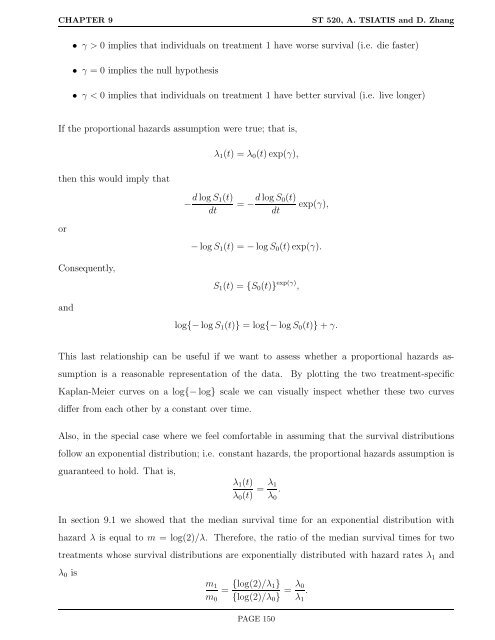ST 520 Statistical Principles of Clinical Trials - NCSU Statistics ...
ST 520 Statistical Principles of Clinical Trials - NCSU Statistics ...
ST 520 Statistical Principles of Clinical Trials - NCSU Statistics ...
You also want an ePaper? Increase the reach of your titles
YUMPU automatically turns print PDFs into web optimized ePapers that Google loves.
CHAPTER 9 <strong>ST</strong> <strong>520</strong>, A. TSIATIS and D. Zhang<br />
• γ > 0 implies that individuals on treatment 1 have worse survival (i.e. die faster)<br />
• γ = 0 implies the null hypothesis<br />
• γ < 0 implies that individuals on treatment 1 have better survival (i.e. live longer)<br />
If the proportional hazards assumption were true; that is,<br />
then this would imply that<br />
or<br />
Consequently,<br />
and<br />
d log S1(t)<br />
−<br />
dt<br />
λ1(t) = λ0(t) exp(γ),<br />
d log S0(t)<br />
= − exp(γ),<br />
dt<br />
− log S1(t) = − log S0(t) exp(γ).<br />
S1(t) = {S0(t)} exp(γ) ,<br />
log{− log S1(t)} = log{− log S0(t)} + γ.<br />
This last relationship can be useful if we want to assess whether a proportional hazards as-<br />
sumption is a reasonable representation <strong>of</strong> the data. By plotting the two treatment-specific<br />
Kaplan-Meier curves on a log{− log} scale we can visually inspect whether these two curves<br />
differ from each other by a constant over time.<br />
Also, in the special case where we feel comfortable in assuming that the survival distributions<br />
follow an exponential distribution; i.e. constant hazards, the proportional hazards assumption is<br />
guaranteed to hold. That is,<br />
λ1(t)<br />
λ0(t)<br />
λ1<br />
= .<br />
λ0<br />
In section 9.1 we showed that the median survival time for an exponential distribution with<br />
hazard λ is equal to m = log(2)/λ. Therefore, the ratio <strong>of</strong> the median survival times for two<br />
treatments whose survival distributions are exponentially distributed with hazard rates λ1 and<br />
λ0 is<br />
m1<br />
m0<br />
= {log(2)/λ1}<br />
{log(2)/λ0}<br />
PAGE 150<br />
λ0<br />
= .<br />
λ1
















